Douglas C-124 Globemaster II Video - Picture
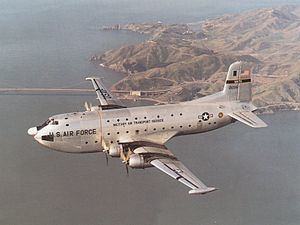
|
|
Douglas C-124 Globemaster II
C-124 Globemaster II

Role: Heavy-lift military transport aircraft
Manufacturer: Douglas Aircraft Company
First flight: 27 November 1949
Introduced: 1950
Retired: 1974 (USAF)
Primary users: United States Air Force
United States Air National Guard
United States Air Force Reserve
Produced: 1949-1955
Number built: 448 (9 surviving)
Developed from: C-74 Globemaster
Developed into: Douglas C-132 (Unbuilt)
The Douglas C-124 Globemaster II, nicknamed "Old Shakey", was a heavy-lift cargo aircraft built by the Douglas Aircraft Company in Long Beach, California.
The C-124 was the primary heavy-lift transport for United States Air Force Military Air Transport Service (MATS) during the 1950s and early 1960s until the C-141 Starlifter entered service. It served in MATS, later Military Airlift Command (MAC), gained units of the Air Force Reserve and Air National Guard until 1974.
Development
The C-124 was developed from 1947 to 1949 by Douglas Aircraft from a prototype created from the WWII-design Douglas C-74 Globemaster and based on lessons learned in the Berlin Airlift. The aircraft was powered by four large Pratt & Whitney R-4360 piston engines producing 3,800 hp (2,800 kW) each. The C-124's design featured two large clamshell doors and a hydraulically-actuated ramp in the nose as well as a cargo elevator under the aft fuselage. The C-124 was capable of carrying 68,500 lb (31,100 kg) of cargo, and the 77 ft (23 m) cargo bay featured two overhead hoists, each capable of lifting 8,000 lb (3,600 kg). As a cargo hauler, it could carry tanks, guns, trucks and other heavy equipment, while in its passenger-carrying role it could carry 200 fully equipped troops on its double decks or 127 litter patients and their attendants. It was the only aircraft of its time capable of transporting heavy equipment such as tanks and bulldozers without prior disassembly.
The C-124 first flew on 27 November 1949, with the C-124A being delivered from May, 1950. The C-124C was next, featuring more powerful engines, and an APS-42 weather radar fitted in a "thimble"-like structure on the nose. Wingtip-mounted combustion heaters were added to heat the cabin, and enable wing and tail surface deicing. The C-124As were later equipped with these improvements.
One C-124 (BuNo 52-1069) was used for testing the 15,000 shp (11,000 kW) Pratt & Whitney XT57 (PT5) turboprop, which was installed in the nose.
Operational history
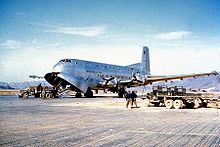
Picture - An early C-124A during the Korean War.
First deliveries of the 448 production aircraft began in May 1950 and continued until 1955. The C-124 was operational during the Korean War, and was also used to assist supply operations for Operation Deep Freeze in Antarctica. They performed heavy lift cargo operations for the US military worldwide, including flights to Southeast Asia, Africa and elsewhere. From 1959 to 1961 they transported Thor missiles across the Atlantic to England. The C-124 was also used extensively during the Vietnam War transporting material from the U.S. to Vietnam. Until the C-5A became operational, the C-124 was the only aircraft available that could transport very large loads.
The United States Air Force Strategic Air Command (SAC) was the initial operator of the C-124 Globemaster, with 50 in service from 1950 through 1962. Four squadrons operated the type, consisting of the 1st, 2nd, 3rd and 4th Strategic Support Squadrons. Their primary duty was to transport nuclear weapons between air bases and to provide airlift of personnel and equipment during exercises and overseas deployments.
The Military Air Transport Service (MATS) was the primary operator until January 1966, when the organization was retitled Military Airlift Command (MAC). Within a few years following the formation of MAC, the last remaining examples were transferred to the Air Force Reserve (AFRES) and the Air National Guard (ANG), said transfers being complete by 1970. The first ANG unit to receive the C-124C was the last Air Force unit to retire their aircraft (AF Serial No. 52-1066 & 53-0044) in September 1974.
Variants
YC-124
Prototype re-built from a C-74 with a new fuselage and powered by four 3,500 hp R-4360-39 engines, it was later re-engined and re-designated YC-124A.
YC-124A
Prototype YC-124 re-engined with four 3,800 hp R-4360-35A engines.
C-124A
Douglas Model 1129A, production version with four 3,500 hp R-4360-20WA engines; 204-built, most retrofitted later with nose-radar and combustion heaters in wingtip fairings.
YC-124B
Douglas Model 1182E was a turboprop variant of the C-124A with four YT34-P-6 turboprops, originally proposed as a tanker it was used for trials on the operation of turboprop aircraft.
C-124C
Douglas Model 1317, same as C-124A but with nose radar, wingtip combustion heaters and increased fuel capacity; 243 built.
Operators
United States
United States Air Force
60th Military Airlift Wing - Travis AFB, California
Geographically Separated Unit - Hill Air Force Base, Deactivated 1968(?)
62nd Military Airlift Wing - McChord AFB, Washington
4th Military Airlift Squadron
7th Military Airlift Squadron
8th Military Airlift Squadron
19th Military Airlift Squadron (Geographically Separated Unit) - Kelly AFB, Texas, Deactivated 22 December 1969
63d Military Airlift Wing - Donaldson AFB, South Carolina; Hunter AFB, Georgia; Norton AFB, California
14th Military Airlift Squadron
15th Military Airlift Squadron
65th Military Airlift Wing - Tachikawa Air Base, Japan
22nd Military Airlift Squadron
374th Troop Carrier Group - Tachikawa Air Base, Japan
22nd Troop Carrier Squadron, Heavy
435th Troop Carrier Wing, Heavy - Homestead AFB, Florida
78th Troop Carrier Squadron
436th Military Airlift Wing - Dover AFB, Delaware
20th Military Airlift Squadron
31st Military Airlift Squadron
437th Military Airlift Wing - Charleston AFB, South Carolina
14th Military Airlift Squadron
17th Military Airlift Squadron
1501st Air Transport Wing, Heavy - Travis AFB, California
1502d Air Transport Wing (Hickam AFB) (Hawaii) Later 61st Military Airlift Wing at same Location
75th Air Transport Squadron, Heavy
1607th Air Transport Wing, Heavy - Dover AFB, Delaware
Air National Guard
118th Military Airlift Group - Nashville International Airport/ANGB, Tennessee (1967-1971)
105th Military Airlift Squadron
137th Military Airlift Group - Will Rogers World Airport/ANGS, Oklahoma (1967-1971)
185th Military Airlift Squadron
125th Military Airlift Squadron (Tulsa International Airport/ANGB, Oklahoma) (1967-1971)
145th Air Transport Group (Heavy)/145th Tactical Airlift Group - Charlotte Douglas International Airport/ANGB, North Carolina (1967-1971)
151st Military Airlift Group - Salt Lake City International Airport/ANGB, Utah (1969-1972)
191st Military Airlift Squadron
164th Military Airlift Group - Memphis International Airport/ANGB, Tennessee (1967-1974)
165th Military Airlift Group - Savannah International Airport/ANGB, Georgia (1967-1974)
158th Military Airlift Squadron
172d Military Airlift Group - Jackson International Airport/ANGB], Mississippi (1953-1972)
183rd Military Airlift Squadron
Air Force Reserve
349th Troop Carrier Wing - Hamilton AFB, California (1966-1969)
445th Military Airlift Wing - Dobbins AFB, Georgia (1965-1971)
512th Military Airlift Wing - Carswell AFB, Texas (1965-71)
911th Military Airlift Group - Pittsburgh International Airport/ARS, Pennsylvania (1966-72)
915th Military Airlift Group - Homestead AFB, Florida (1964-69)
932d Military Airlift Group - Scott AFB, Illinois (1966-1971)
917th Military Airlift Group - Barksdale AFB, Louisiana (1963-1972)
Survivors
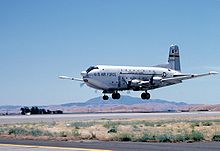
Picture - C-124C 52-1000 making its last landing at Travis Air Force Base, 10 June 1984.
C-124 (AF Ser. No. 49-0258) is currently being restored at the Air Mobility Command Museum located at Dover Air Force Base near Dover, Delaware. This is the oldest surviving C-124. In July 2005, museum volunteers reattached the aircraft's wings and clamshell doors.
C-124C (AF Ser. No. 51-0089) is on display at the Museum of Aviation located at Robins Air Force Base in Georgia.
C-124 (AF Ser. No. 52-0943) is on display at the Seoul Military Academy Museum at Sacheon Air Force Base in Seoul, South Korea.
C-124 (AF Ser. No. 52-0994) is on display at the McChord Air Museum located at McChord Air Force Base in Tacoma, Washington. This aircraft was formerly under civilian registration N86599 and located for many years at the Detroit Institute of Aeronautics. On 9 October 1986 the aircraft was flown non-stop from Selfridge Air National Guard Base near Detroit, Michigan to McChord Air Force Base. While flying over Washington State the aircraft was joined by a Lockheed C-130 Hercules and Lockheed C-141 Starlifter of McChord's elite 62nd Military Airlift Wing. This is the last recorded flight of a C-124. The museum has been subject to restricted access since 11 September 2001.
C-124 (AF Ser. No. 52-1000) is on display at The Travis Air Museum, located inside Travis Air Force Base near San Francisco, California. The museum was given the C-124 in August 1982. The aircraft had been stored for many years outside at the Aberdeen Proving Ground in Maryland where it was used as a storage shed. Transporting the aircraft by ground to California would have been prohibitively expensive so the decision was made to fly the aircraft to the museum. Volunteers joined with members of the Air National Guard's 116th Tactical Fighter Wing from Dobbins Air Force Base to restore the C-124 to an airworthy and ferryable condition. The aircraft was then ferried from Aberdeen to Dobbins AFB in Georgia where members of the 116th TFW completed the aircraft's restoration. The aircraft was then flown cross country to Norton Air Force Base in California. After a photo session over the Golden Gate Bridge the C-124 arrived at the Travis Air Museum at exactly 1400 on 10 June 1984. This was the first recorded flight of a C-124 in nearly a decade.
C-124 (AF Ser. No. 52-1004) is displayed at the Pima Air and Space Museum adjacent to Davis Monthan Air Force Base in Tucson, Arizona.
C-124 (AF Ser. No. 52-1066) is located at the National Museum of the United States Air Force at Wright-Patterson Air Force Base near Dayton, Ohio. This aircraft is stored indoors with the clamshell doors open, allowing visitors to go inside. This was one of the last two Air National Guard C-124s to be retired in 1974. The aircraft is displayed as AF Ser. No. 51-0135.
C-124 (AF Ser. No. 52-1072) is on display at the Charleston Air Force Base airpark located in Charleston, South Carolina.
C-124 (AF Ser. No. 53-0044), one of the last two Air National Guard C-124s to be retired in 1974, was located for many years on the corner of Koval Lane and Reno Avenue near McCarran International Airport in Paradise, Nevada. Numerous plans were made to use the aircraft for advertising, display, and even as a restaurant, but nothing came of this and over the years the aircraft's condition deteriorated.
C-124 (AF Ser. No. 53-0050) has undergone restoration at the Hill Aerospace Museum located at Hill Air Force Base, Utah. The aircraft was rescued from Aberdeen Proving Ground in Maryland in 1992 where it was planned to be used for ballistics testing.
Accidents and incidents
June 18, 1953 - A C-124 took off from Tachikawa Air Base in Japan. Shortly after takeoff, one of the engines failed, forcing the pilot to make an emergency landing. Due to a loss of airspeed, the pilot lost control and crashed into a rice field, killing all seven crew and 122 passengers. It is the worst accident involving a C-124.
Specifications (C-124 Globemaster II)
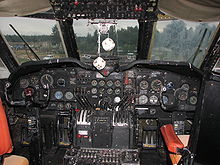
Picture - Cockpit of C-124 on display at the McChord Air Museum, McChord AFB, WA.
General characteristics
Crew: 6
Length: 130 ft (40 m)
Wingspan: 174 ft 1 in (53.06 m)
Height: 48 ft 4 in (14.7 m)
Wing area: 2,510 ft² (233.2 m²)
Empty weight: 100,000 lb (46,000 kg)
Loaded weight: 195,000 lb (88,000 kg)
Max takeoff weight: 216,000 lb (98,000 kg)
Powerplant: 4x— Pratt & Whitney R-4360 "Wasp Major" radial engines, 3,800 hp (2,834 kW) each
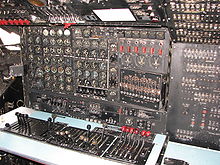
Picture - Flight engineer's station of a C-124.
Performance
Maximum speed: 320 mph (280 kn, 520 km/h)
Range: 2,175 mi (1,890 nmi, 3,500 km)
Service ceiling: 34,000 ft (10,000 m)
Wing loading: 77.7 lb/ft² (379 kg/m²)
Power/mass: 0.078 hp/lb (128 W/kg)
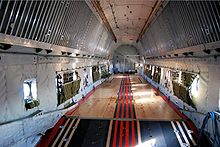
Picture - C-124A cargo deck.
Boeing C-17 Globemaster III
Related development
C-74 Globemaster
Douglas C-132
Comparable aircraft
C-97 Stratofreighter
Saunders-Roe Princess
Boeing 377 Stratocruiser
Bibliography
Connors, Jack (2010). The Engines of Pratt & Whitney: A Technical History. Reston. Virginia: American Institute of Aeronautics and Astronautics. ISBN 978-1-60086-711-8.
Francillon, René J. McDonnell Douglas Aircraft since 1920. London: Putnam, 1979. ISBN 0-370-00050-1.
Douglas C-124 Globemaster II Pictures
More aircraft.
Source: WikiPedia